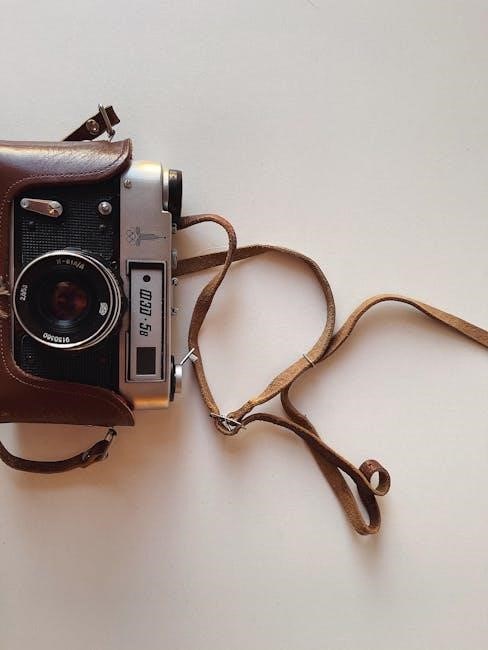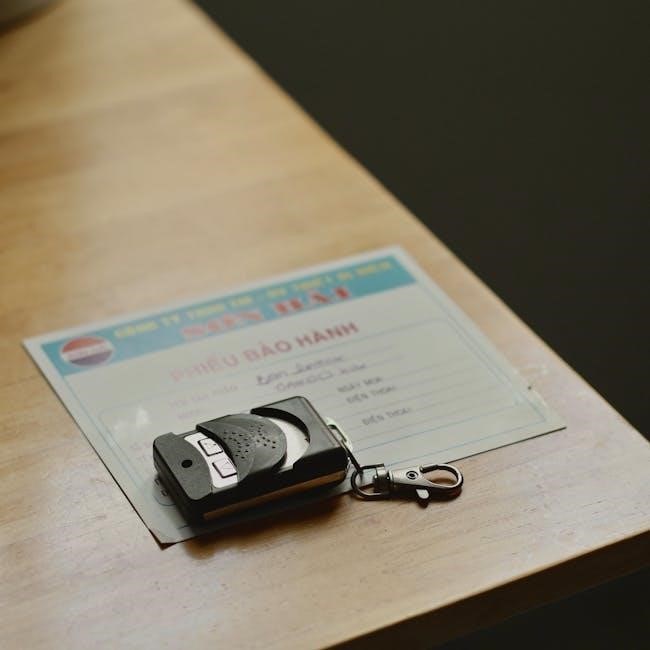Dymo Rhino 5200 Manual: An Overview
The Dymo Rhino 5200 manual serves as a comprehensive guide to understanding and utilizing this industrial label printer․ It provides instructions on various features, from basic operations to advanced customization․ Users can find information on label creation, memory management, troubleshooting, and safety precautions․ This manual will help with its effective use․

Getting Started with Your Rhino 5200
To begin using your Rhino 5200 label printer, start by loading the battery or connecting the power adapter․ Ensure the device is properly powered on before proceeding․ Next, insert a compatible label cartridge into the designated compartment, making sure it clicks into place․ The Rhino 5200 supports various label widths, so select the appropriate cartridge for your needs․
Once the label cartridge is installed, familiarize yourself with the printer’s interface․ The ABC keyboard layout allows for easy text input, and the LCD screen displays the label being created․ Navigate the menu options to set the desired language and other preferences․ Before printing, it’s advisable to perform a test print to ensure the label is aligned correctly and the print quality is satisfactory․
Explore the printer’s basic functions such as text formatting, symbol insertion, and serialization․ The manual provides detailed instructions on how to access and utilize these features․ Additionally, learn how to save label files to the printer’s memory for future use․ Remember to consult the troubleshooting section of the manual if you encounter any difficulties during the setup process․ Proper handling and setup will ensure optimal performance of your Rhino 5200 label printer․
Familiarizing yourself with these initial steps will pave the way for efficient and effective label creation with your new device․
Key Features and Functions
The Dymo Rhino 5200 boasts several key features designed to enhance label creation efficiency and versatility․ One notable function is its ability to meet ANSI and TIA/EIA 606-A labeling standards, ensuring compliance with industry requirements․ The printer provides access to over 100 industry symbols, fractions, and punctuation marks, accessible through quick keystrokes, streamlining the labeling process for specialized applications․
Serialization is another prominent feature, allowing for the creation of sequential labels with ease․ This is particularly useful for numbering cables, equipment, or other items requiring unique identifiers․ The Rhino 5200 also offers a 100-character memory capacity, enabling users to save and recall frequently used label designs, saving time and effort․
Furthermore, the printer’s “hot keys” provide one-touch access to commonly used formatting options such as wire/cable wraps, flags, and patch panel labels․ Its rugged design, including a rubber grip, ensures durability and slip-resistant handling in demanding work environments․ The backlit display enhances visibility in low-light conditions, while the automatic label cutter simplifies the label application process․ These features combine to make the Rhino 5200 a powerful and user-friendly labeling tool for professionals․

Label Customization Options
The Dymo Rhino 5200 offers extensive label customization options to meet diverse labeling needs․ Users can adjust the label size to accommodate different applications, utilizing labels ranging from 6mm to 19mm in width․ The printer supports various label materials, including flexible nylon, polyester, and vinyl, each suited for specific surfaces and environmental conditions․
Font styles and sizes are adjustable, allowing users to create clear and readable labels․ Bold, italic, and underlined text options further enhance customization․ The Rhino 5200 also provides options for framing and bordering labels, adding visual emphasis․ Vertical printing is supported for labeling cables and wires․
Furthermore, users can insert symbols and punctuation marks from the printer’s extensive library, catering to specialized labeling requirements․ The ability to save and recall frequently used label designs streamlines the creation process for recurring tasks․ The “hot keys” offer quick access to pre-set formatting options, such as wire wraps and flags, simplifying complex label layouts․ These features empower users to create professional and informative labels tailored to their specific needs․

Using Industry Symbols and Punctuation
The Dymo Rhino 5200 excels in providing access to a wide range of industry symbols and punctuation, crucial for professional labeling in various sectors․ With a few keystrokes, users can access over 100 industry-specific symbols, adhering to ANSI and TIA/EIA 606-A labeling standards․ These symbols are essential for clear communication in electrical, telecommunications, and other technical fields․
Accessing these symbols is straightforward, typically involving a dedicated “Symbols” key or menu․ Once accessed, users can browse through categories or use search functions to locate the required symbol․ Punctuation marks, including fractions, are also readily available, ensuring accurate and detailed labeling․
The Rhino 5200’s interface allows for easy insertion of these symbols and punctuation marks into labels․ The clear display ensures users can verify the correct characters before printing․ This capability minimizes errors and ensures labels are compliant with industry standards․ By streamlining access to specialized characters, the Rhino 5200 simplifies complex labeling tasks, improving efficiency and accuracy․
Deleting Label Files from Memory
The Dymo Rhino 5200 allows users to store frequently used label designs in its memory for quick access․ However, as memory fills up or label needs change, deleting old or obsolete label files becomes necessary․ This process is designed to be simple and efficient, ensuring users can manage their stored labels effectively․
To delete a label file from memory, start by pressing the designated “Memory” or “Saved Labels” button on the Rhino 5200․ This action displays a list of all currently stored label files․ Navigate through the list using the arrow keys to select the label file you wish to delete․ Once the desired file is highlighted, press the “Delete” button․ A confirmation prompt will appear, asking you to confirm the deletion․ Select “Yes” to proceed with the deletion, or “No” to cancel․
After confirming, the selected label file will be permanently removed from the Rhino 5200’s memory․ This process frees up space for new label designs․ Regularly deleting unused label files helps maintain an organized and efficient labeling workflow, preventing confusion and ensuring the Rhino 5200 operates smoothly․ Remember to always double-check the file name before confirming deletion to avoid accidentally deleting important labels․

Cleaning and Maintenance
Maintaining your Dymo Rhino 5200 label printer is crucial for ensuring its longevity and consistent performance․ Regular cleaning prevents label jams, print quality issues, and other malfunctions․ Proper maintenance also extends the life of the print head and other critical components․
To clean the exterior of the Rhino 5200, use a soft, dry cloth to wipe away dust and debris․ For stubborn stains, dampen the cloth slightly with water or a mild cleaning solution․ Avoid using harsh chemicals or solvents, as they can damage the printer’s casing․ The print head requires special attention․ Use a cotton swab lightly dampened with isopropyl alcohol to gently clean the print head surface․ This removes any adhesive residue or ink buildup that can affect print quality․
The label path should also be cleaned periodically․ Open the label cartridge compartment and remove any loose label scraps or debris․ Use a soft brush or compressed air to dislodge any remaining particles․ Always ensure the printer is turned off and the power adapter is disconnected before performing any cleaning or maintenance tasks․ Following these simple steps will help keep your Rhino 5200 in optimal condition, providing reliable labeling for years to come․
Troubleshooting Common Issues
The Dymo Rhino 5200, while a robust label printer, may occasionally encounter issues․ One common problem is poor print quality, often indicated by faded or incomplete characters․ This is frequently caused by a dirty print head, which can be resolved by gently cleaning it with isopropyl alcohol and a cotton swab․ Another issue is label jams, which occur when the label tape becomes stuck within the printer mechanism․ To clear a jam, carefully open the label compartment and remove any obstructions, ensuring the tape path is clear․
If the printer fails to power on, check the battery or power adapter․ Ensure the battery is properly charged or the adapter is securely connected․ Error messages displayed on the LCD screen can provide valuable clues to the problem․ Consult the user manual for a list of error codes and their corresponding solutions․ If the printer is not cutting labels properly, inspect the cutter blade for damage or debris․ A dull or obstructed blade may need cleaning or replacement․
In cases where the printer freezes or becomes unresponsive, try performing a reset by removing the battery for a few minutes․ If issues persist, contacting Dymo’s customer support or consulting online resources may provide further assistance․ Regular cleaning and proper handling can prevent many common problems, ensuring the Rhino 5200 operates smoothly․
Safety Precautions and Battery Information
When operating the Dymo Rhino 5200, adhering to safety precautions is crucial to prevent injury and ensure the longevity of the device․ Always use the printer in a well-ventilated area, avoiding exposure to extreme temperatures or humidity․ Do not attempt to disassemble or modify the printer, as this could lead to electrical shock or malfunction․ Keep the printer away from water and other liquids to prevent damage to the internal components․
Regarding battery information, the Rhino 5200 typically uses a rechargeable lithium-ion battery pack․ Handle the battery with care, avoiding punctures or exposure to fire․ Use only the specified charger provided by Dymo to prevent overcharging or damage to the battery․ When disposing of the battery, follow local regulations for proper disposal of lithium-ion batteries․ Do not incinerate or dispose of the battery in general waste․ If you notice the battery swelling, leaking, or overheating, discontinue use immediately and contact Dymo customer support․ Always store the battery in a cool, dry place when not in use․ By following these guidelines, you can ensure safe and reliable operation of your Rhino 5200 label printer․

